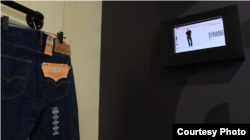Visit your local shopping mall recently? Increasingly, the answer is "no." The convenience of shopping from the comfort of your home, at your fingertips, is here to stay. And that has offline retailers worried.
While retailers remain focused on meeting demand for a seamless mobile shopping experience, offline stores are finding new ways — from using the latest in "smart fitting room" technology to interactive home remodeling — to engage customers and remain profitable.
Mobile shopping leads the retail market, currently projected to generate $630 billion in annual revenue by 2018, an increase from 27 percent to 47 percent of online spending. Online shopping, overall, has pushed the offline experience against the wall.
But don't count out the traditional warehouse store yet.
Take what Intel has coined "the supermarket of the future" — in technological collaboration with Microsoft — designed to provide an interactive shopping experience for customers, while providing cloud-based store management for retailers. Pick up an item and view its origin, nutrients, carbon footprint, and recommended combinations for your next recipe.
Like what you see? Give it a "thumbs up." Stores can now employ camera sensors and perceptual computing technologies from Intel to engage and learn from customers, who need only to respond with a simple sign of approval or disapproval.
Online-offline gap
Of course, there's also virtual reality. The realm of retail technology now extends to more complicated endeavors such as remodeling your home. Sales associates can use miniature physical objects to create 3-D models of room layouts, using Intel's RealSense™ camera and an Oculus Rift virtual reality headset.
Michelle Tinsley, director of mobility and secure payments for Intel's Retail Solutions Division, says the corporation is focused on bridging the gap between online and in-store experiences by helping the retailer to better understand the customer, and provide a better experience in return.
"The workers can then focus on the more loyal customers, and it also gives them insights around what might be the next product I am likely to buy: What are the brands that I'm a fan of? What did I purchase last and what might go great with it?"
Jack Kleinhenz, chief economist for the National Retail Federation, says offline retailers must become more service oriented with customers in order to create lasting relationships.
"We're going to be seeing a transformation to not just pure product, but also services in the store — building that relationship on a collaborative basis with the consumer — giving you feedback and then you, in turn, responding with what they are needing," he said.
Kleinhenz warns that firms need to be careful not to use technology solely for technology's sake — which has evolved quicker than some retailers have been able to adapt — but rather as a "means to the end."
Location technology
Scala, a global provider of digital communications solutions for retailers, features a "fashion wall" that uses location technology to sense when an online "browser" enters the store, while also transferring data on that shopper's browsing preferences onto digital screens.
"We can sense that the person is there, and by doing that we can trigger content on larger playback screens that specifically zoom in on the preferences of that customer," said Harry Horn, Vice President of Global Marketing at Scala.
"For example, they already bought a jacket and a pair of shoes,” he said. “Now we can say, ‘You bought this and this, let's offer you also a pair of jeans and a nice shirt to go with that.' "
Despite such advancements that better utilize customers' personal information in-store, the technology continues to evolve. Similar to Scala's fashion wall, Intel's "smart fitting room," which will soon be featured at Levi Strauss & Co., recommends matching items for customers while connecting them directly with a sales associate. Intel maintains that the technology employed, as part of its retail sensor platform, also preserves customer privacy.












